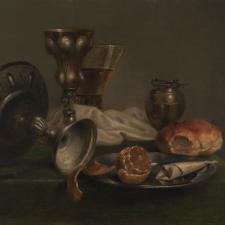The pioneers of Czech Cubism drew on a broad base of inspirations to formulate their creative and intellectual ideas. They embraced a variety of European and non-European cultures of different periods: from Antiquity to the Middle Ages to the Early Modern Age and up to modern French art represented by Paul Cézanne, André Derain, and Pablo Picasso.
The Czech Cubism of the Group of Fine Artists (Skupina výtvarných umělců) is an extraordinary source of material from which to understand how the modernist movement related to European tradition and to ‘other’ art and exotic forms of expression.
The pioneers of Cubism – painters Emil Filla, Vincenc Beneš, Josef Čapek, Antonin Prochazka, sculptor Otto Gutfreund, architects Pavel Janak, Josef Gočar, Josef Chochol, Vlastislav Hofman and others – drew on a broad base of inspirations to formulate their creative and intellectual ideas. Their range of interests was regularly on display between 1911 and 1914 in the group’s Art Monthly review (Umělecký měsíčník) and in the group’s exhibitions.
They embraced a variety of European and non-European cultures of different periods: from Antiquity to the Middle Ages to the Early Modern Age and up to modern French art represented by Paul Cezanne, Andre Derain, and Pablo Picasso. Examples of their work show how they sought to resolve specific problems associated with questions of form and simultaneously to reinforce the legitimacy of modern expression by tying it to a historical tradition.
Czech Cubists built on the French modernism of the mid-19th century but adopted its principles not in mechanically reproduced form but through genuine acts of creativity founded on personal intuition. Emil Filla succinctly summed up their outlook in a study called ‘Life and Work’ published in Art Monthly: ‘Stylistic will is impossible in this era and will always be suspect and cheap as in the distractedness of this age it will inevitably degenerate into stylisation and archaic imitation. The creative work of the individual will require the artist to employ feeling and intuition to re-determine and select for himself a form suited to his creative instinct. In the place of a form generally embraced we shall have the formal sensibility of the individual.’
The title of the exhibition, Rembrandt’s Tram, is not intended as a futuristic or dadaistic play on words. It is a metaphor for the challenges of the subject this book focuses on. Coupling the name of an acknowledged old master with the modern means of transportation portrayed in a painting Tram No. 4 (1912-1913) by Vincenc Beneš, this also being the name Russian avant-garde artists gave to their exhibition in 1915, has a certain paradox to it, which comes to light when considering the links between Cubism as the most current and controversially adopted movement of the given time and earlier and a-stylistic forms of expression.
Among Czech art historians these issues have been addressed most thoroughly by Vojtěch Lahoda, who is currently celebrating an important birthday, and to whom we have dedicated this project. The exhibition and book were prepared by a team of art historians at the Institute of Art History of the Czech Academy of Sciences that includes both experts in modernist and avant-garde art and researchers specialising in the medieval and the early modern eras and studying Cubist inspirations from the perspective of early art. Thanks to this cooperation between these two camps the exhibition explores a rich array of novel approaches to the study of Cubism and its ties to the cultures of other eras and other continents.
Exhibition concept: Tomáš Winter, Lenka Bydžovská, Pavla Machalíková and Taťána Petrasová
Exhibition curators: Ivana Jonáková, Petra Kočová
Graphic design: Tereza Hejmová
Language editor: Lenka Jindrová
Installation: Jan Jirka, Miroslav Tázler
Realization of the text components: Jakub Čermák
Accompanying program: Jiří Hlobil, Iveta Řežábková, Marcela Štýbrová
Artworks on display were loaned by:
COLLETT | Prague, Munich
Galerie Benedikta Rejta v Lounech
Galerie výtvarného umění v Chebu
Moravská galerie v Brně
Muzeum hlavního města Prahy
Národní galerie v Praze
Národní muzeum – Historické muzeum
Národní muzeum – Náprstkovo muzeum asijských, afrických a amerických kultur
Památník národního písemnictví
Ústav dějin umění AV ČR, v. v. i.
Západočeská galerie v Plzni
and private owners
The exhibition has been prepared in cooperation with the National Gallery in Prague and the Institute of Art History of the Academy of Sciences of the Czech Republic.


|
|











